Arma 3 footage is being used as disinformation in the wake of Israel-Hamas war: 'It’s disheartening for us to see the game we all love being used in this way,' says developer
As Arma 3 clips masquerading as real-world news spread on social media, Bohemia Interactive has shared its guide to telling those videos from real-world footage.
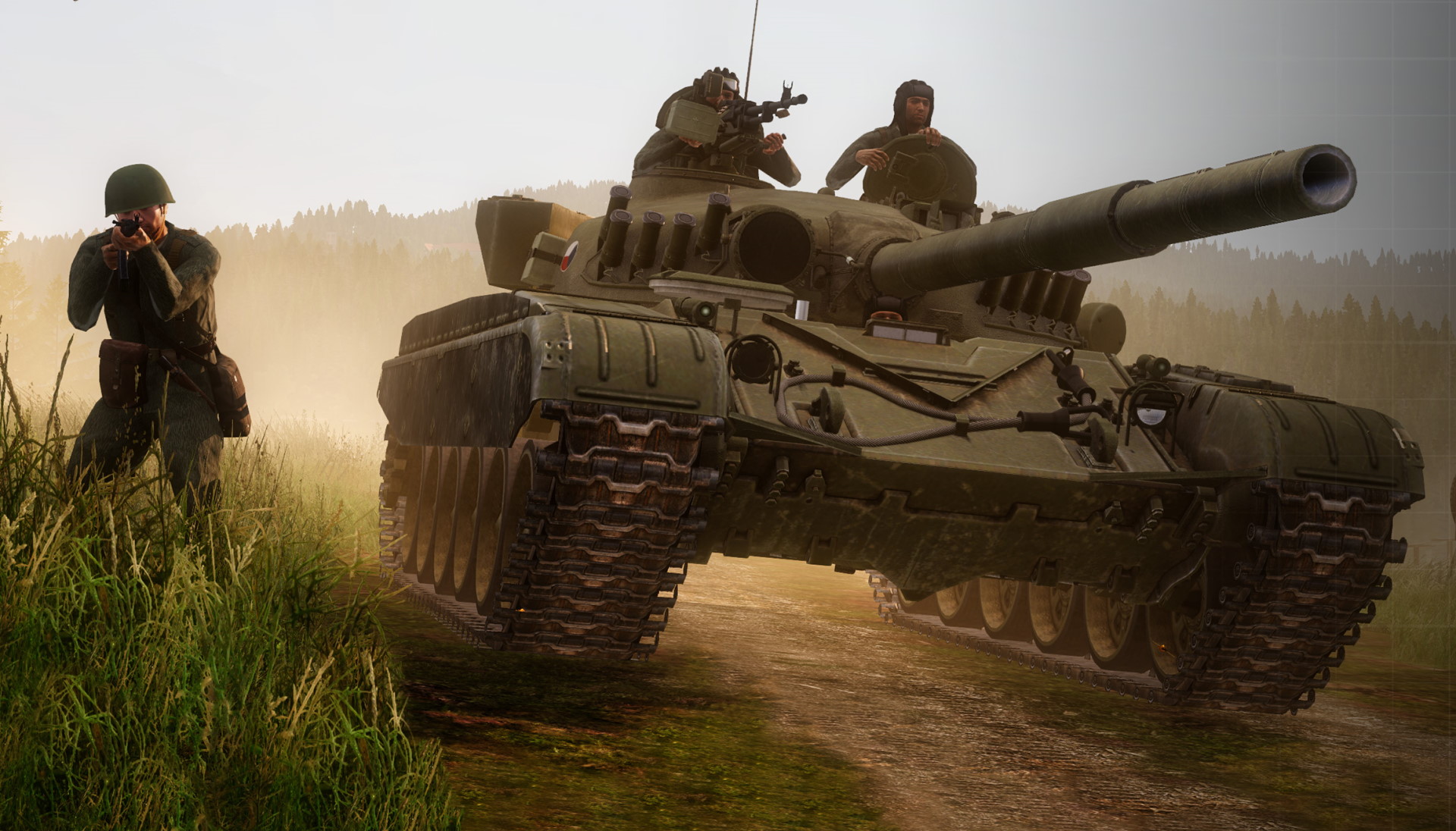
With large-scale hostilities breaking out between Israel and Hamas in the Middle East, Arma 3 developer Bohemia Interactive has issued a statement asking its players and content creators to "use their footage responsibly" in order to avoid contributing to a flood of false information being spread on social media. The studio also shared a detailed guide to help people distinguish videos made in the game from real-world combat footage.
"With the tragic events currently unfolding in the Middle East, we feel it is vital to share once again our statement concerning the use of Arma 3 as a source of fake news footage," the studio wrote on Twitter (X) this week. "It’s disheartening for us to see the game we all love being used in this way. While we have found ways to tackle this issue somewhat effectively by closely cooperating with leading fact-checking agencies, sadly we can't mitigate it entirely."
The use of Arma 3 footage to spread misinformation or disinformation (the latter being deliberately deceiving others with something false or fabricated), is hardly a new phenomenon. Clips masquerading as footage of the Russian invasion of Ukraine were widely shared in early 2022, and in 2021 an Indian news channel broadcast an Arma 3 clip in a report about a Pakistani air force attack on the Panjshir Valley. The same thing happened with its predecessor, Arma 2: In 2011, for instance, a documentary broadcast by British network ITV included footage of a helicopter being shot down by the IRA using weaponry provided by Libya's then-dictator Muammar Gaddafi, which was in fact an Arma 2 gameplay clip.
But in a time when ordinary people are often firsthand sources of photos and video from conflict zones, the misuse of Arma 3 footage has become a more pressing concern. It's a problem that's grown exponentially worse on Twitter in particular following the decision to remove any sort of meaningful verification system for legitimate news outlets. BBC journalist Shayan Sardarizadeh, for one, has recently documented multiple instances of Arma 3 footage being used in false reports on Twitter about the conflict between Israel and Palestine:

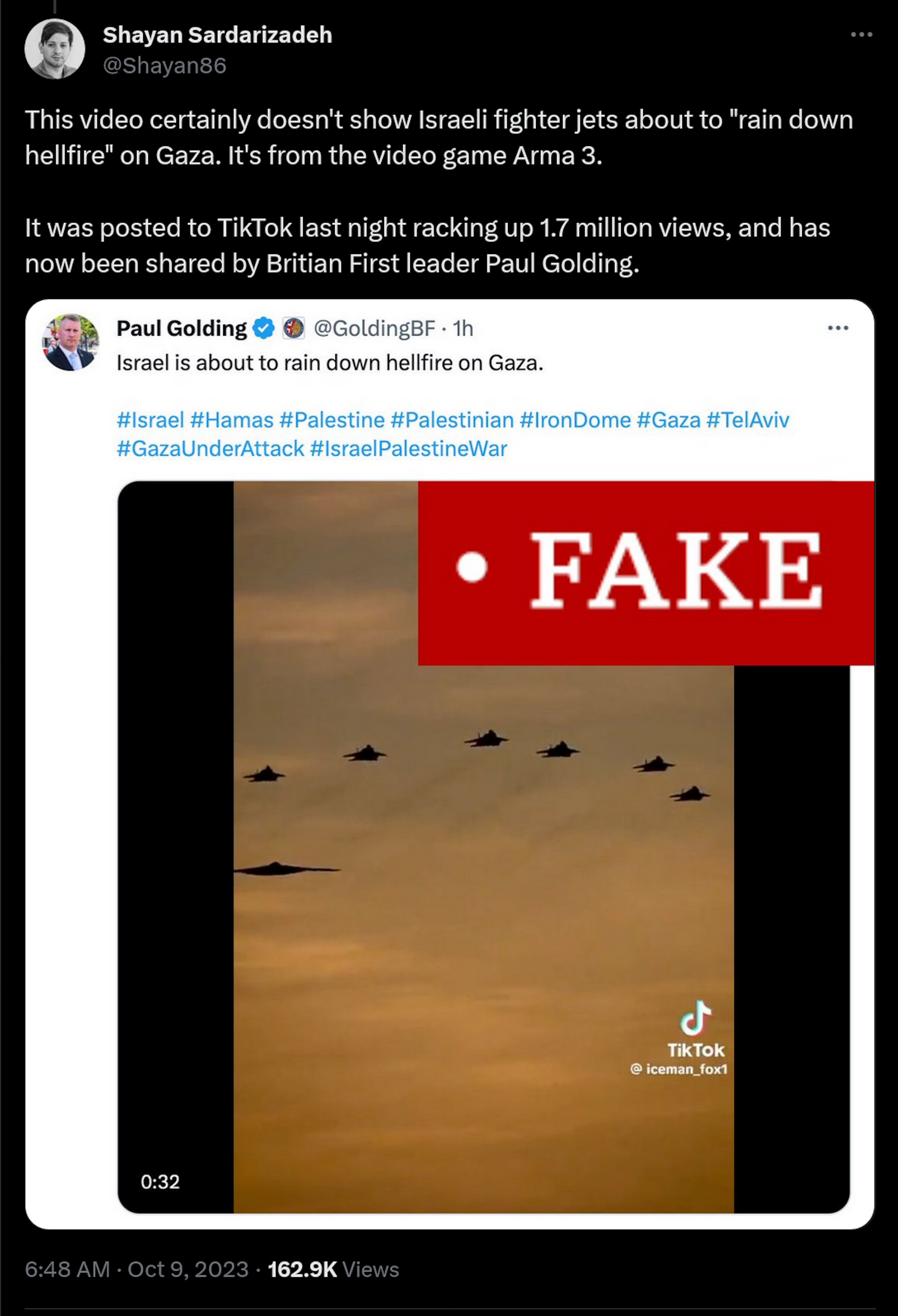
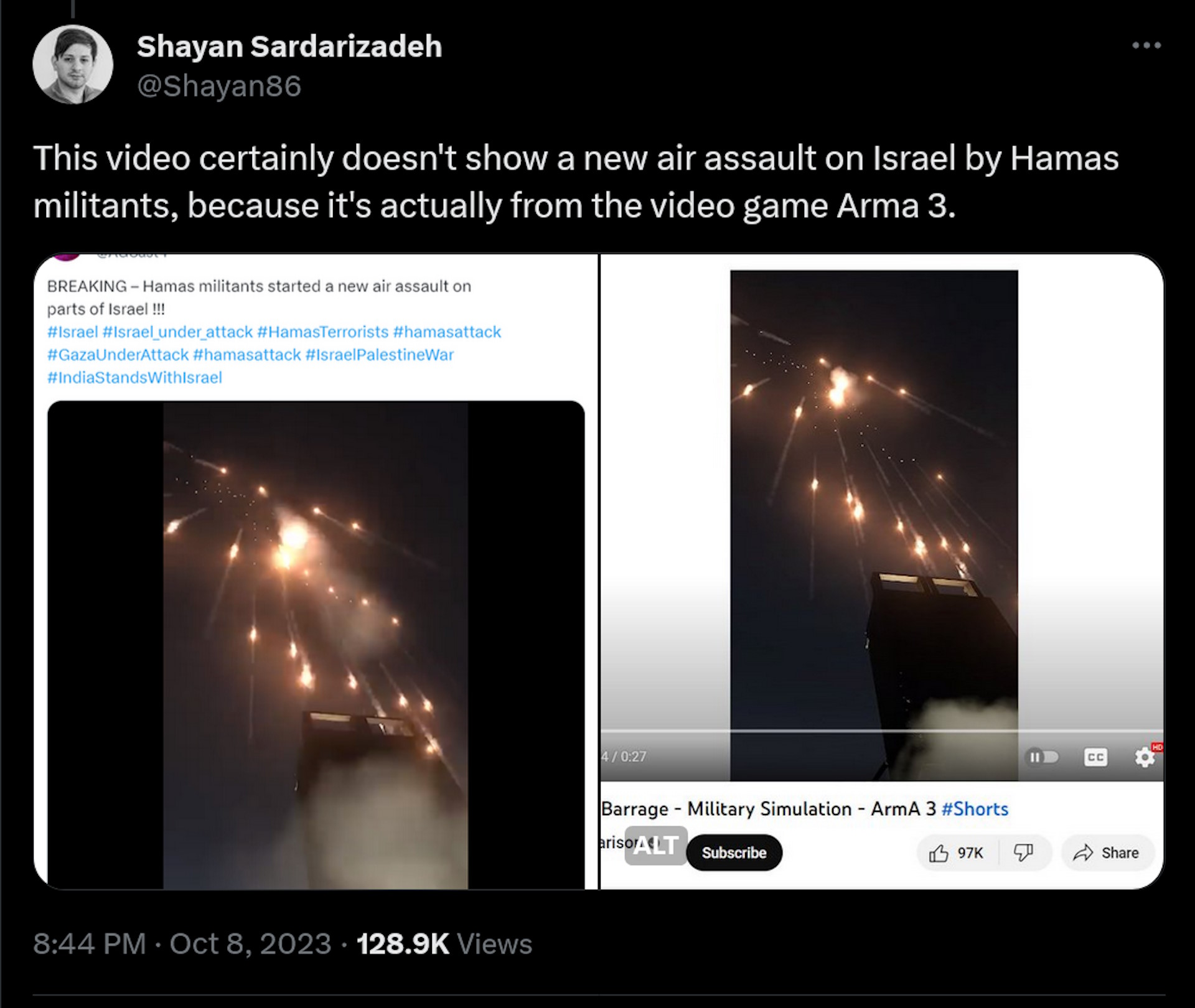
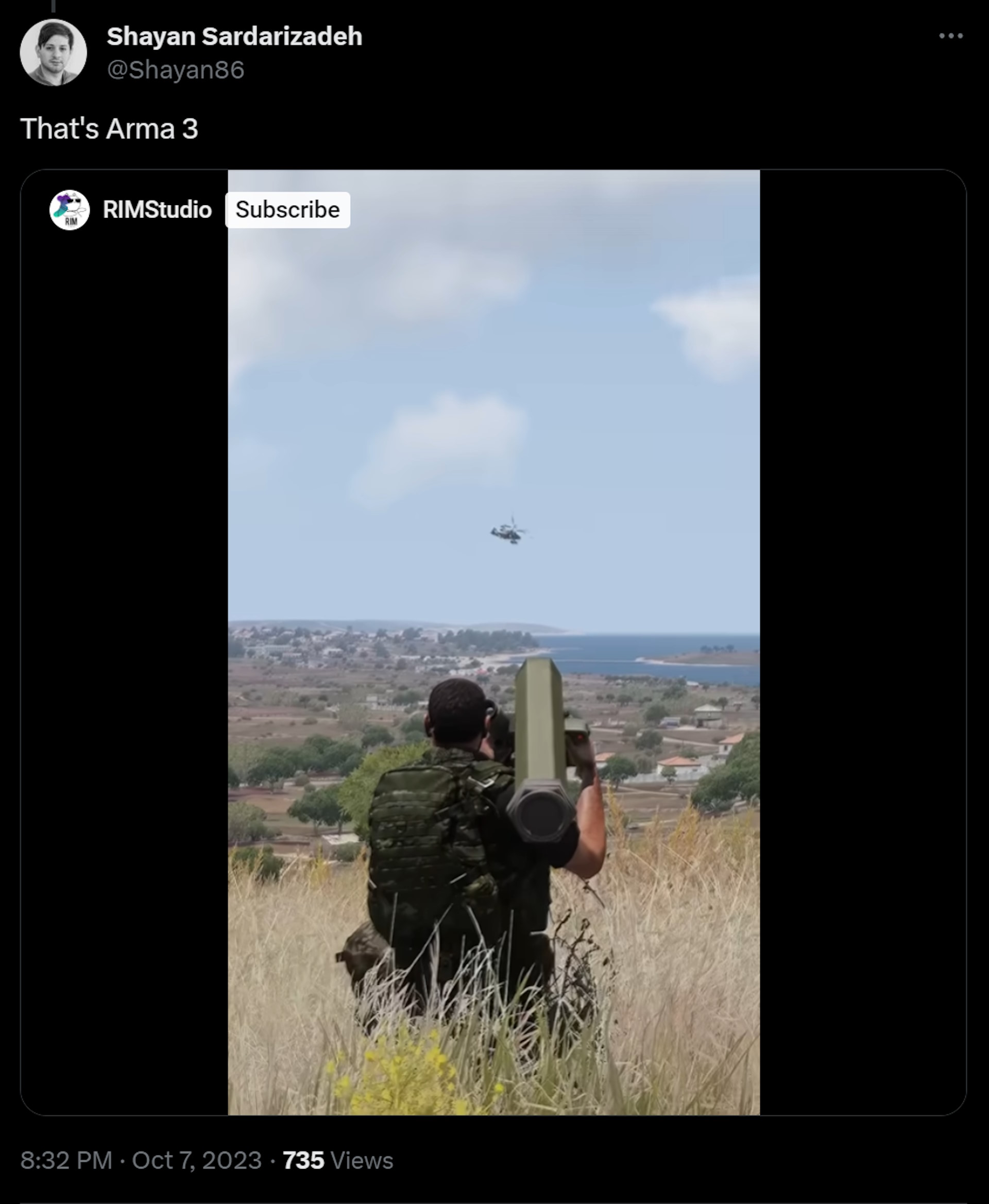
The outbreak of large-scale hostilities between Israel and Hamas last week prompted Bohemia Interactive to repeat its call to fans to be careful with how they share and use Arma 3 clips. "As of today, there are more than 20.000 Arma 3 mods available to download via the Steam Workshop," the studio said. "This means that players of Arma 3 can recreate and simulate any historic, present, or future conflict in great detail (thanks to its advanced game engine). This unique freedom of the Arma 3 platform comes with a downside: videos taken from Arma 3, especially when the game is modified, are quite capable of spreading fake news."
The blog post is actually a repeat of a message Bohemia posted shortly after Russia launched its invasion of Ukraine. The studio said it was "vital" to share the message again in response to "the tragic events currently unfolding in the Middle East." It also thanked fans for their efforts in helping to debunk reports using Arma 3 videos.
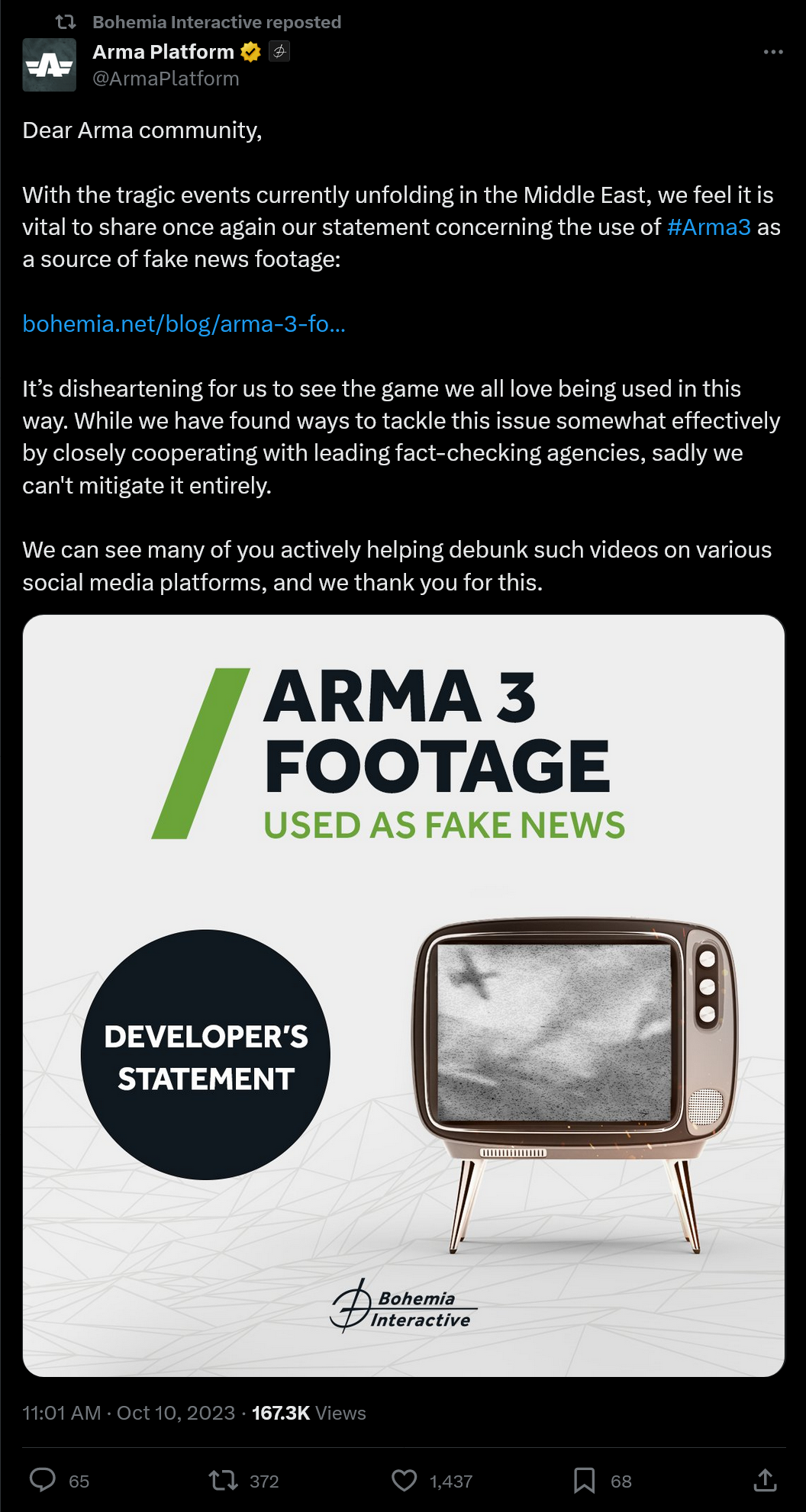
"We can see many of you actively helping debunk such videos on various social media platforms, and we thank you for this," Bohemia tweeted.
To help with that process, Bohemia included a list of tips to help tell Arma 3 videos from real-world footage:
The biggest gaming news, reviews and hardware deals
Keep up to date with the most important stories and the best deals, as picked by the PC Gamer team.
- Very low resolution - Even dated smartphones have the ability to provide videos in HD quality. Fake videos are usually of much lower quality, and are intentionally pixelated and blurry to hide the fact that they’re taken from a video game.
- Very low resolution - To add dramatic effect, these videos are often not captured in-game. Authors film a computer screen with the game running in low quality and with an exaggerated camera shake.
- Often takes place in the dark / at night - The footage is often dark in order to hide the video game scene’s insufficient level of detail.
- Mostly without sound - In-game sound effects are often distinguishable from reality.
- Doesn't feature people in motion - While the game can simulate the movement of military vehicles relatively realistically, capturing natural looking humans in motion is still very difficult, even for the most modern of games.
- Heads Up Display (HUD) elements visible - Sometimes the game’s user interfaces, such as weapon selection, ammunition counters, vehicle status, in-game messages, etc. are visible. These commonly appear at the edges or in the corners of the footage.
- Unnatural particle effects - Even the most modern games have a problem with naturally depicting explosions, smoke, fire, and dust, as well as how they’re affected by environmental conditions. Look for oddly separated cloudlets in particular.
- Unrealistic vehicles, uniforms, equipment - People with advanced military equipment knowledge can recognize the use of unrealistic military assets for a given conflict. For instance, in one widely spread fake video, the US air defense system C-RAM shoots down a US A-10 ground attack plane. Units can also display non-authentic insignias, camouflage, etc.

Andy has been gaming on PCs from the very beginning, starting as a youngster with text adventures and primitive action games on a cassette-based TRS80. From there he graduated to the glory days of Sierra Online adventures and Microprose sims, ran a local BBS, learned how to build PCs, and developed a longstanding love of RPGs, immersive sims, and shooters. He began writing videogame news in 2007 for The Escapist and somehow managed to avoid getting fired until 2014, when he joined the storied ranks of PC Gamer. He covers all aspects of the industry, from new game announcements and patch notes to legal disputes, Twitch beefs, esports, and Henry Cavill. Lots of Henry Cavill.

